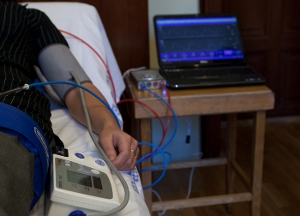“Semmelweis University acts openly in the interest of prevention. It is our goal to ensure that a preventive approach is inherent in doctors receiving their medical diplomas in the coming years. Thus, 2012 has been declared the Year of Prevention at Semmelweis University,” said Rector Tivadar Tulassay, announcing also that Semmelweis students will now be performing screening tests on approximately 10,000 patients per year as part of the new Prevention for Health course.
 Vice-Rector Ágoston Szél related that Hungary has a low participation rate in institutionally organised screening test campaigns. The Prevention for Health course will be a compulsory elective subject for students of all six faculties, as a part of which each student will be required to find at least ten people and involve them in a screening examination. “People need to be convinced and enlightened, they need to be taught to take care of their health, and so the direct public health benefit of such an initiative is in itself significant, while indirectly it may provide opportunities for scientific work. Thus, Prevention for Health will be a summons for interested, motivated patients and the doctors who perform screening tests alike,” the vice-rector added.
Vice-Rector Ágoston Szél related that Hungary has a low participation rate in institutionally organised screening test campaigns. The Prevention for Health course will be a compulsory elective subject for students of all six faculties, as a part of which each student will be required to find at least ten people and involve them in a screening examination. “People need to be convinced and enlightened, they need to be taught to take care of their health, and so the direct public health benefit of such an initiative is in itself significant, while indirectly it may provide opportunities for scientific work. Thus, Prevention for Health will be a summons for interested, motivated patients and the doctors who perform screening tests alike,” the vice-rector added.
Prevention has held an important place at Semmelweis University in previous years as well, an example of which is the detailed cardiovascular study launched in Budakalász by Semmelweis University, the Hungarian Society of Cardiology, TÁRKI and the Municipality of Budakalász. The goal of this endeavour is to involve the town’s entire adult population (c. 8000 people) in screening tests and to analyse cardiovascular diseases and mortality within social, economic and cultural contexts. Statistical data indicate that 52 percent of Hungarians die as a result of cardiovascular disease. Compared to the European Union average, Hungarians are more likely to smoke and drink alcohol, while their consumption of fruits and vegetables, as well as their tendency to exercise is below the average. Taken together, these risk factors contribute to some 80 percent of cardiovascular deaths. Dr. Béla Merkely, director of the University’s Heart Centre related that this University-initiated study may provide the foundation for the definition of national public health strategies in the coming years and decades.
 The study, financed in part by the “Modern Medical Technologies at Semmelweis University” grant (TÁMOP-4.2.1.B-09/1/KMR-2010-0001) is still underway, though several startling data have already emerged, Dr. Merkely revealed. High blood pressure, high cholesterol and an abnormal Ankle-Brachial Pressure index – a sign of peripheral arterial disease of the legs – accounted for 49.4, 26.7 and 10.9 percent of the most important risk factors for cardiovascular disease, respectively. The national average BMI index is 28.3, an indication of excess weight. Fifteen percent of the population is unaware that their blood pressure is too high and do not take medication to control it, while 14 percent are ignorant of the fact that their cholesterol is above the healthy level.
The study, financed in part by the “Modern Medical Technologies at Semmelweis University” grant (TÁMOP-4.2.1.B-09/1/KMR-2010-0001) is still underway, though several startling data have already emerged, Dr. Merkely revealed. High blood pressure, high cholesterol and an abnormal Ankle-Brachial Pressure index – a sign of peripheral arterial disease of the legs – accounted for 49.4, 26.7 and 10.9 percent of the most important risk factors for cardiovascular disease, respectively. The national average BMI index is 28.3, an indication of excess weight. Fifteen percent of the population is unaware that their blood pressure is too high and do not take medication to control it, while 14 percent are ignorant of the fact that their cholesterol is above the healthy level.
The cross-sectional study is set to conclude within three years, after which a long-term follow-up investigation will commence. It is anticipated that these will result in a number of scientific observations, which may later contribute to the development of a preventive mindset among the general population and the improvement of the public condition.
2011 was the Year of Research and Innovation at Semmelweis University, an initiative that was, in part, tied to the prestigious “Research University” title, which the University received the year prior.
Zsuzsa Szuchy
Translated by Gina Gönczi



